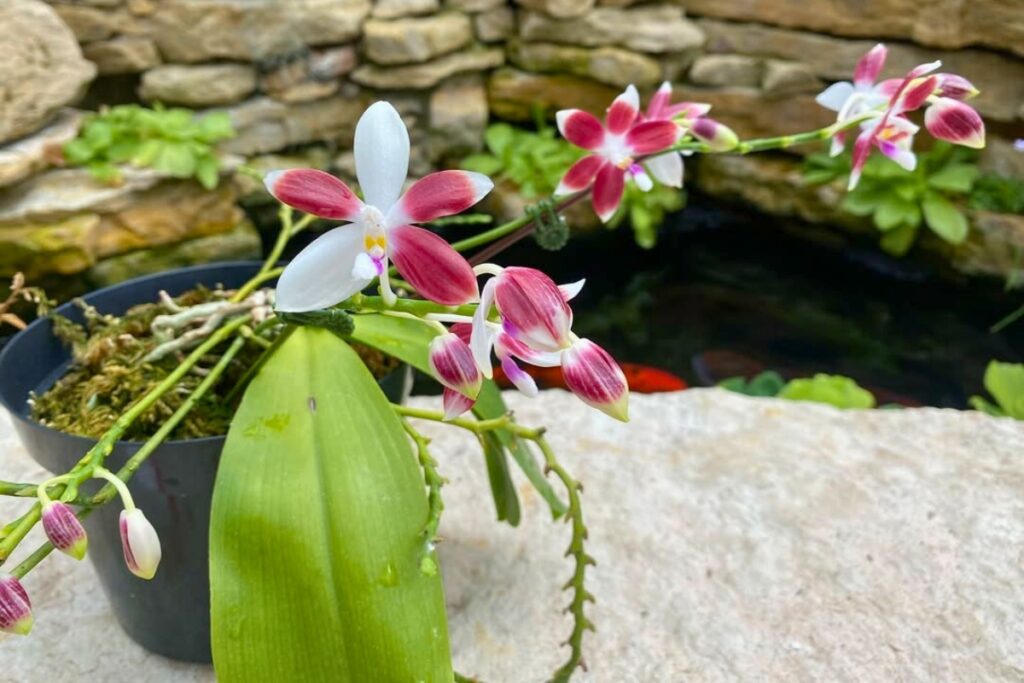If you’ve recently acquired a Phalaenopsis orchid or you’re struggling to keep one alive, you’re not alone. These elegant plants have earned an undeserved reputation for being difficult, but they’ll thrive under your care once you understand their basic needs. While they won’t survive total neglect, you’ll find that these tropical beauties are surprisingly adaptable and will reward your attention with months of stunning blooms.

Contents
Creating the Perfect Light and Temperature Balance
Why do so many orchid owners struggle with lighting and temperature? It’s because Phalaenopsis orchids need specific conditions that aren’t always intuitive. Your orchids will thrive in bright, indirect light – think sheer-curtained windows facing east or north.
Keep temperatures between 65-80°F during the day and 60-65°F at night. You’ll know the light’s too intense if leaves turn yellowish-green or feel warm to touch. If leaves are dark green, they’re not getting enough light.
Place your orchid 3-5 feet from windows to prevent sunburn, and don’t let leaves touch cold windowpanes in winter. Monitor leaf temperature by touching them midday – they should feel cool, not warm.
Mastering Water and Humidity Requirements
Getting light and temperature right sets the stage, but proper watering and humidity make or break your orchid’s success. Water your phalaenopsis thoroughly when the potting mix feels dry about 1 inch below the surface, typically every 7-10 days.
Maintain humidity levels between 50-70% by placing a humidity tray filled with pebbles and water beneath your pot. Don’t let the pot’s bottom touch the water, as this can lead to root rot.
During winter months, you’ll need to water less frequently, about every 10-14 days. Never let water collect in the crown (center) of the plant, and always water in the morning to allow excess moisture to evaporate.
Selecting the Right Potting Medium and Container
Successful orchid growing depends heavily on choosing the right potting medium and container combination. You’ll want to select a coarse, well-draining mix that includes bark chunks, perlite, and sphagnum moss in a 3:1:1 ratio. Avoid regular potting soil, as it retains too much moisture.
For containers, choose clear plastic pots with plenty of drainage holes, ideally 4-6 inches in diameter. These allow you to monitor root health and provide essential airflow. Make sure there’s about 1 inch of space around the roots when repotting, and always use clean, sterilized containers to prevent disease.
Fertilizing Strategies for Healthy Growth and Blooming
Beyond proper potting, your Phalaenopsis orchid needs regular nutrients to thrive. During active growth, apply a balanced 20-20-20 water-soluble fertilizer every two weeks, diluted to quarter strength.
In winter months, reduce fertilizing to once monthly, as your orchid’s growth naturally slows. You’ll want to use a “weakly, weekly” approach – it’s better to fertilize lightly but frequently than to overfeed.
Watch for signs of over-fertilization, like leaf tip burn or crusty salt buildup. If you notice these issues, flush the potting medium thoroughly with plain water and reduce your fertilizer concentration until new growth appears healthy.
Identifying and Treating Common Orchid Problems
While Phalaenopsis orchids are generally hardy plants, they can develop several common issues that you’ll need to address quickly. Yellow leaves often indicate overwatering, while wrinkled leaves suggest underwatering. Check your orchid’s roots weekly – brown, mushy roots signal root rot, while healthy roots appear green or silvery.
Spotting on leaves might mean fungal infection, which requires immediate treatment with a fungicide. Watch for tiny brown spots (scale insects) or webbing (spider mites), and treat with neem oil or insecticidal soap. If your orchid’s buds drop before opening, it’s likely experiencing temperature fluctuations or drafts.
